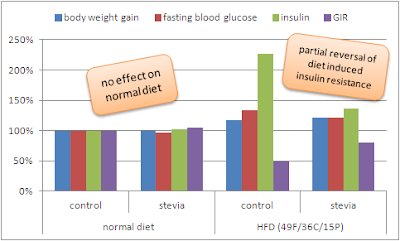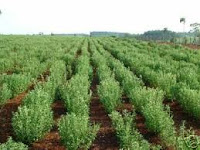Stevia Increases Satellite Cell Recruitment and Ameliorates Insulin Resistance by Reducing NF-KappaB Mediated Inflammatory Response to Muscle Damage & High Fat Diet
Sclafani. 2010), you could also make a point that the rodents might have "tasted" that there is more to Stevia rebaudiana than its insanely sweet taste (personally, I have been using stevia for ~6months, now, and had to get used to the taste initially), if you take a closer look at some of the more recent data on the potential health benefits of (allegedly large amounts of) steviosids, the major steviol glycosides from the leaves of the stevia plant.
Steviosids work via NF-kappaB by reducing inflammation
Assuming that you have followed the Intermittent Thoughts on Building Muscle series, you will be familiar with the notion that the recruitment of so-called satellite-cells, i.e. muscle-specific stem-cells, is an essential part of the repair process after exercise (or otherwise) induced muscle damage. You will also be aware that inflammation plays an important, albeit hitherto not fully elucidated role in this process and that it is after the initial inflammation is abating, when the macrophages start the actual (re-)construction process (cf. "Inflammation & Hypertrophy"). You will thusly maybe even less surprised than a group of Malayan scientists from the Mahidol University in Bangkok (Bunprajun. 2012), when they found that 10mg/kg of pure steviosids, of which previous studies had already shown that they are able to ameliorate stress-induced NF-kappaB (which is believed to be one of the master regulators of inflammatory responses) expression, did not only lead to the expected amelioration in NF-kappaB expression in cardiotoxin injected tibialis muscles of male rodents, but also increased the post-recovery increase in myo-D positive, i.e. newly recruited satellite cells.
The initial NF-kappaB response, three days after the injection of a cardiotoxin into the tibialis muscles of the rodents was identical (cf. figure 1). After seven days, however, the NF-kappaB levels in the steviosid group, who received their daily dose of stevia 7 days before and in the 7 days after the injury, are significantly lower than in their vehicle (control) treated peers and correspond well with the profoundly increased number of myoD
positive (fresh) nuclei in the stained tissue samples of the treatment group.
The same effects on NF-kappaB also help ameliorate diet-induced insulin resistance
With the increased recruitment of satellite cells being only part of a very complex repair process, and given the fact that the scientists did not find any significant difference in tibialis anterior mass, myofibrillar protein content, the number of central located nuclei, it is actually not surprising that the contractile function of the injured legs was still identical 7 days after this profound injury. For an athlete or any active individual this would probably mean a few weeks away from the gym, the court, the green, or the stadium and this in turn could precipitate weight gain, which brings up another nice "side effect" of the NF-kappaB suppressing effects of high dose stevia supplementation that has been recently established by Wang et al. (Wang. 2012).
As the data in figure 2 goes to show, the oral administration of stevisoids as 2x10mg/kg was able to ameliorate the negative effects 4 months of "high fat" feeding (49% fat / 36% carbs / 15% protein) exerted on body weight and glucose metabolism of previously healthy rats. With a +36% increase in serum insulin and a -19% reduced glucose infusion response (GIR) the rats in the HFD+stevia group were yet still significantly more insulin resistant than their peers on the regular diet - and the results also show that an increase in insulin sensitivity does not translate into a decrease in weight gain. As we are going to see in the course of the current Intermittent Thoughts series on insulin sensitivity, "ideally" the exact opposite should be the case.
Pounding stevia to stay healthy and gain muscle? Probably not the best good idea.
If we get back to my introductory remarks and the not really advertisable slogan "rats would buy stevia rebaudiana", the question that has to be answered now is: Would you buy stevia? I already told you that I do, but certainly not because of the aforementioned effects. I guess, I would probably die from over-sweetening (if there was such a thing), if I took the corresponding one to two "servings" of 1.6mg/kg (human equivalent of 10mg/kg for a rat) of pure steviosids on a daily basis... but all jokes aside, if you are looking for a healthy sweetener, there probably is no better option than stevia.
If you want to ward off insulin resistance, on the other hand, a "clean" diet with a reasonable amounts of carbs (unless you are diabetic ~100g, which as Beth /thx/ rightly pointed out would be way less than 30% of your total energy intake, is something everyone should be able to handle - and what's more, can help you perform better, keep energy levels and metabolism up and contrary to the contemporary anti-carb paradigm, eventually improve weight- and fat-loss), fats and protein in it should be your main concern. This is particularly important, because a combination of the latter with a reasonable workout routine, sufficient time to recover and a decent amount of quality sleep, will also make the use of stevia as a means to increase muscle repair obsolete,... at least as long as you are not attacked by mad Malayan scientist with a syringes full of myotoxins ;-)
Steviosids work via NF-kappaB by reducing inflammation
Assuming that you have followed the Intermittent Thoughts on Building Muscle series, you will be familiar with the notion that the recruitment of so-called satellite-cells, i.e. muscle-specific stem-cells, is an essential part of the repair process after exercise (or otherwise) induced muscle damage. You will also be aware that inflammation plays an important, albeit hitherto not fully elucidated role in this process and that it is after the initial inflammation is abating, when the macrophages start the actual (re-)construction process (cf. "Inflammation & Hypertrophy"). You will thusly maybe even less surprised than a group of Malayan scientists from the Mahidol University in Bangkok (Bunprajun. 2012), when they found that 10mg/kg of pure steviosids, of which previous studies had already shown that they are able to ameliorate stress-induced NF-kappaB (which is believed to be one of the master regulators of inflammatory responses) expression, did not only lead to the expected amelioration in NF-kappaB expression in cardiotoxin injected tibialis muscles of male rodents, but also increased the post-recovery increase in myo-D positive, i.e. newly recruited satellite cells.
 |
| Figure 1: Inflammatory response (left) and satellite cell recruitment (right) after cardiotoxin injection in tibialis muscle in rodents after pre treatment (7 days) and concomitant (7 days after the injury) treatment with vehicle (control) or 10mg/kg steviosids (data adapted from Bunprajun. 2012) |
The same effects on NF-kappaB also help ameliorate diet-induced insulin resistance
With the increased recruitment of satellite cells being only part of a very complex repair process, and given the fact that the scientists did not find any significant difference in tibialis anterior mass, myofibrillar protein content, the number of central located nuclei, it is actually not surprising that the contractile function of the injured legs was still identical 7 days after this profound injury. For an athlete or any active individual this would probably mean a few weeks away from the gym, the court, the green, or the stadium and this in turn could precipitate weight gain, which brings up another nice "side effect" of the NF-kappaB suppressing effects of high dose stevia supplementation that has been recently established by Wang et al. (Wang. 2012).
 |
| Figure 2: Body weight gain, fasting blood glucose and insulin levels and glucose infusion response in rats after 4 months on regular or high fat diet (49%fat / 36%carbs / 15% protein) with or without 2x10mg/kg steviosids per day (data calculated based on Wang. 2012) |
Pounding stevia to stay healthy and gain muscle? Probably not the best good idea.
If we get back to my introductory remarks and the not really advertisable slogan "rats would buy stevia rebaudiana", the question that has to be answered now is: Would you buy stevia? I already told you that I do, but certainly not because of the aforementioned effects. I guess, I would probably die from over-sweetening (if there was such a thing), if I took the corresponding one to two "servings" of 1.6mg/kg (human equivalent of 10mg/kg for a rat) of pure steviosids on a daily basis... but all jokes aside, if you are looking for a healthy sweetener, there probably is no better option than stevia.
If you want to ward off insulin resistance, on the other hand, a "clean" diet with a reasonable amounts of carbs (unless you are diabetic ~100g, which as Beth /thx/ rightly pointed out would be way less than 30% of your total energy intake, is something everyone should be able to handle - and what's more, can help you perform better, keep energy levels and metabolism up and contrary to the contemporary anti-carb paradigm, eventually improve weight- and fat-loss), fats and protein in it should be your main concern. This is particularly important, because a combination of the latter with a reasonable workout routine, sufficient time to recover and a decent amount of quality sleep, will also make the use of stevia as a means to increase muscle repair obsolete,... at least as long as you are not attacked by mad Malayan scientist with a syringes full of myotoxins ;-)



